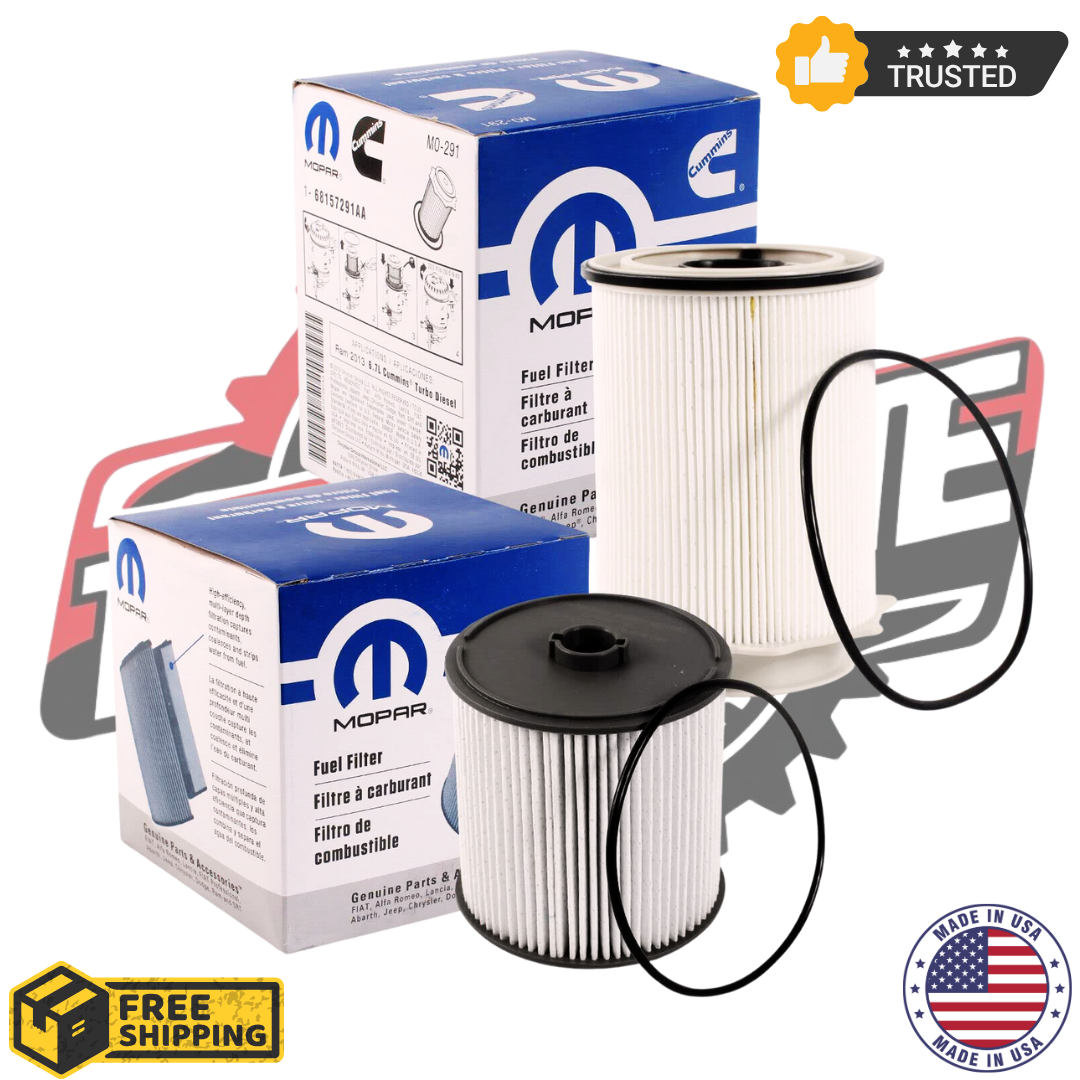
2019-2024 DODGE RAM 2500-5500 6.7L MOPAR FUEL FILTERS 68157291AA, 68436631AA KIT OEM
High-performance engine filtration
$85.99$58.99
MOPAR FUEL FILTER KIT FOR 2019-2024 DODGE RAM 2500-5500 6.7L
Upgrade your 2019-2024 Dodge Ram 2500 or 3500 with the Mopar OEM Fuel Filter Kit designed for the 6.7L Cummins turbo diesel engine. This kit, featuring part numbers 68157291AA and 68436631AA (MO-291, MO-631), enhances engine efficiency and performance.
We provide fast shipping, volume discounts, and free delivery throughout the USA. These high-quality Mopar filters are specifically engineered for the 2019-2024 Dodge Ram 2500-3500 models, effectively removing contaminants to ensure reliable engine performance.
Brand: Mopar
Part Numbers: 68157291AA, 68436631AA (MO-291, MO-631)
SKU: B4L1015AW
Weight: 1.02 pounds
Dimensions: 10.08 x 4.84 x 4.49 inches
Product Grade: Performance Part
2019-2024 Dodge RAM 2500 6.7L Cummins Turbo Diesel
2019-2024 Dodge RAM 3500 6.7L Cummins Turbo Diesel
2019-2024 Dodge RAM 4500 6.7L Cummins Turbo Diesel
2019-2024 Dodge RAM 5500 6.7L Cummins Turbo Diesel
1x Mopar 68157291AA Primary Fuel Filter
1x Mopar 68436631AA Secondary Fuel Filter
TOOLS AND SUPPLIES NEEDED
New Fuel Filters:
Mopar 68157291AA (Primary Fuel Filter)
Mopar 68436631AA (Secondary Fuel Filter)
Fuel filter wrench (if needed)
Socket set and ratchet
Safety glasses and gloves
Rags
Small container or tray (to catch any fuel drips)
PREPARATION STEPS
Park the Vehicle:
Ensure the truck is on a level surface with the parking brake engaged. The engine should be off and cooled down.
Lift the Vehicle (if necessary):
If access to the fuel filters requires it, lift the front end with a jack and secure with jack stands.
RELIEVE FUEL SYSTEM PRESSURE
Locate the Fuel Pump Fuse/Relay:
Check your owner’s manual for its position in the fuse box.
Remove the Fuse/Relay:
Pull the fuse or relay to disable the fuel pump.
Start the Engine and Let It Stall:
This relieves pressure in the fuel system. Turn off the ignition once the engine stalls.
Reinstall the Fuse/Relay:
Place the fuel pump fuse or relay back in its original position.
REMOVING AND INSTALLING THE FUEL FILTERS
Locate the Fuel Filters:
Primary Fuel Filter (Mopar 68157291AA): Typically near the engine along the fuel line.
Secondary Fuel Filter (Mopar 68436631AA): May be further down the fuel line or near the fuel tank.
Remove the Old Fuel Filters:
Position Rags: Place rags or a container under the filters to catch spilled fuel.
Disconnect Fuel Lines: Use a fuel filter wrench to disconnect the lines from the old filters, being prepared for fuel spillage.
Remove Filters: Unscrew both the primary and secondary fuel filters.
Install the New Fuel Filters:
Prepare New Filters: Optionally, pre-fill them with clean diesel fuel.
Install Primary Fuel Filter (Mopar 68157291AA): Position and hand-tighten the new filter, ensuring it’s oriented correctly.
Install Secondary Fuel Filter (Mopar 68436631AA): Position and hand-tighten the new filter, checking its orientation.
Reconnect Fuel Lines: Attach the fuel lines to the new filters and secure them.
Check for Leaks:
Turn Ignition On: Without starting the engine, turn the key to the "On" position to pressurize the system.
Inspect for Leaks: Look around both filters for leaks and ensure all connections are tight.
FINAL STEPS
Lower the Vehicle (if lifted):
Carefully remove jack stands and lower the vehicle.
Start the Engine:
Start the engine and let it run for a few minutes, checking for proper operation and leaks.
Dispose of Old Filters:
Take old filters to a recycling center or an auto parts store that accepts them.
Record Maintenance:
Document the filter replacement for future reference.
Note: Always consult your Dodge Ram’s service manual for specific instructions and torque specifications. If you're unsure about any steps, seek assistance from a professional mechanic.


